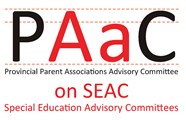Click here to download the original PDF file
The Provincial Parent Association Advisory Committee on Special Education Advisory Committees (PAAC on SEAC) was established in 1983 and is the only group in Ontario that brings together provincial parent associations to communicate and co-operate on issues pertaining to SEACs. PAAC, and its member organizations, encourage valuable partnerships among trustees, educators, voluntary associations and parents. PAAC on SEAC members have been working closely to improve SEAC effectiveness and communication, and to assist Ontario’s students with special education needs through our shared advocacy.
Highlights of 2015-16
Parents Reaching Out (PRO) Provincial Grant
PAAC on SEAC was awarded a grant of $17,500, by the Ministry of Education, Parent Engagement Office, to develop SEAC training resources. The lead agency for the grant was the Ontario Brain Injury Association and under Katie Muirhead’s leadership the following resources were developed:
- Revised PAAC on SEAC Effective Practices Handbook for SEAC Members in English and French
- Three SEAC training modules on
- Purpose of a Special Education Advisory Committee
- Roles and Responsibilities
- Meeting Process
The three new video training modules, and updated Handbooks are available on the PAAC on SEAC website and YouTube Channel.
Meetings with Ministry of Education
In April 2016, the new Director of the Special Education Policy and Programs Branch (SEPPB), Louise Sirisko, attended the PAAC on SEAC meeting. At the meeting Director Sirisko provided an update in several areas of special education including:
- The decision by the Ministry of Education to limit new announcements and initiatives while labour negotiations were on-going
- The work underway on the new guide, Special Education in Ontario: Kindergarten to Grade 12
- The status of the review of the definitions for categories of exceptionality of Behaviour and Intellectual (including Gifted, Mild Intellectual Disability and Developmental Disability)
PAAC on SEAC members also met three times this year with Paul Grogan, Education Officer, SEPPB, who is the liaison for PAAC on SEAC at the Ministry. At the meetings that Paul attended be provided updates on the meetings of the Minister’s Advisory Council on Special Education as well as the Special Education Updates provided by the Ministry.
PAAC on SEAC Monthly Meetings
Other topics discussed at the regular meetings include:
- Accessibility:
- David Lepofsky, Chair of the Accessibility for Ontarians with Disabilities Act (AODA) Alliance, presented on the need for an Accessibility Standard on Education directed at eliminating barriers in our education system (including post-secondary, pre-school, and job training programs).
- AODA is advocating for the establishment of a committee that includes representatives from the disability community and special education sector to identify barriers that recur in the school system, and make a proposal that details what the standards might include. Many education groups including those representing elementary teachers, secondary schools, and universities support the AODA’s call for such a committee
- The Alliance encourages Ontarians to document their concerns about accessibility through the Picture our Barriers campaign
- Special Education Plans:
- PAAC on SEAC heard from a number of SEACs with concerns about how SEAC is involved in the development of the annual Special Education Plan. The discussion raised questions about who the target audience is for the Special Education Plan (Ministry, parents, general public) and how to make the information easy to read and understand by parents.
- Special Education Funding:
- PAAC on SEAC heard from SEACs that are concerned about the negative impact of the new special education funding model on some school boards, especially those with relatively small special education budgets.
- It was reported that some SEAC members do not have a good understanding of the Differentiated Special Education Needs Amount (DSENA) and there is a need for more education of SEAC members about the funding model
- Members of PAAC on SEAC agreed there is a need for continuous information-sharing about and evaluation of the special education funding model to meet student needs across the province.
- Special Needs Strategy:
- Members shared regular updates on the progress of the provincial Special Needs Strategy, including:
- Submission of proposals from the regional planning tables by the June 15th and October 30th, 2015 deadlines
- Announcement in the March 2016 budget of $17 million in funding to support the Special Needs Strategy, through the hiring of Service Coordinators.
- Release of the Program Guidelines for the Integration of Rehabilitation Services, including occupational therapy, physiotherapy and speech-language pathology services.
- The Program Guidelines, and the Special Need Strategy, are intended to improve services for families and to make it easier to navigate the system. Work is on-going and is still not clear how services will change or impact the school system.
- Youth Perspective
- In May 2016, the Provincial Advocate for Children & Youth released a report from the We Have Something to Say Consultation: We Have Something to Say: Young people and their families speak out about special needs and change.
- The report highlights the request from youth to have a say in how services for young people with special needs are developed, and especially in the planning for their personal care.
- Members shared regular updates on the progress of the provincial Special Needs Strategy, including:
This report provides a few of the highlights of the activities of PAAC on SEAC in the past year. For more information about PAAC on SEAC please check the website or contact the Co-Chairs at info@paac-seac.ca. A list of PAAC on SEAC members is shown on the following page and new members are welcomed.
![]()
Alison Morse
Past Chair

Katie Muirhead
Chair
